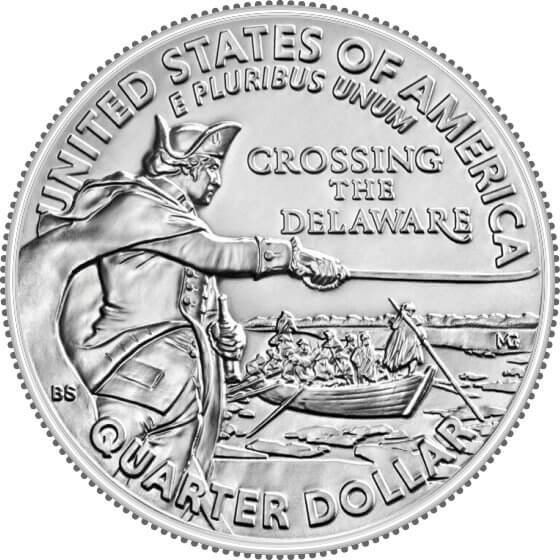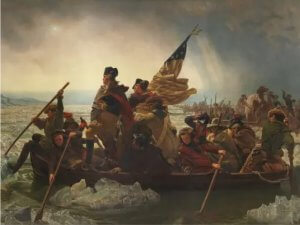
The authorizing law for the American the Beautiful Quarter program included a provision that gave the Secretary of the Treasury the authority to continue the series after the planned end of the program in early 2021 with the release of the Tuskegee Airmen National Historic Site Quarter.
That enabling legislation (Public Law 110-456) specified that after the conclusion of the program, the reverse design would depict General George Washington crossing the Delaware River to lead his forces in an attack at Trenton on British Forces on Christmas Day, 1776 – one of the most famous battles of the war.
It also said that the obverse design will revert to renowned designer John Flanagan’s design featuring President Washington that appeared on the coin prior to the State Quarters Program. But instead of the 15% reduced version of that bust that appeared on the ATB and State quarters from 1999 to 2021, the full-sized version of Flanagan’s portrait was to be used.
Meanwhile, the Treasury opted not to continue the ATB series, and the U.S. Congress authorized a new program – the American Women Quarters – that would begin in 2022. The 2021 Washington Crossing the Delaware Quarter would be a one-year subtype or transition coin between the end of the ATB coins and the start of AWQ.
The coin has a reverse design depicting General George Washington crossing the Delaware River before the Battle of Trenton during the American Revolutionary War. On December 25, 1776, General Washington, along with 2,400 troops and artillery, began his historic crossing of the Delaware River in preparation for a surprise attack on British and Hessian soldiers. The obverse was specified in the law and was the last coin to feature the bust of Washington that appeared in one form or another since 1932.
When the design review committees met to consider designs from the Mint’s artists for the new coin in 2019, they both recommended the same design – the one that eventually appeared on the coin – with the Commission on Fine Arts pointing out that since the 1999 New Jersey State Quarter featured the very same theme, it was essential to have a design that did not repeat the same imagery. A member of the Citizens Coinage Advisory Committee also pointed out that the design had the benefit of being historically accurate.
Released into circulation starting on April 5, 2021, the new coin was struck at the Philadelphia and Denver Mints in circulating quality to the tune of over 1.5 billion coins over the course of the year. In addition, copper-nickel and .999 fine silver versions were struck at the San Francisco Mint, included in the 2021 Proof Set and the 2021 Silver Proof Set.
Unlike the ATB quarters, this coin was not sold in bags and rolls to the public at a premium and could only be obtained in circulation. No coins were struck at the San Francisco Mint in circulation quality, only for the annual sets.
The obverse features the familiar image of George Washington by John Flanagan, used on the quarter since 1932. The style of the design and the inscriptions return to how they appeared on the quarter before the State Quarters Program began in 1999.
The reverse side depicts General George Washington in full uniform, wearing his hat, commanding his troops through the overnight crossing of the ice-choked Delaware River before the Battle of Trenton during the American Revolutionary War. The general is shown on the left from the side, pointing his sword across the river with one of his boats appearing in the background in the icy water.
Washington Crossing the Delaware Quarter Mintages
- 2021-D Washington Crossing the Delaware Quarter: 865.4 million
- 2021-P Washington Crossing the Delaware Quarter: 838.4 million
Washington Crossing the Delaware Quarter Specifications
- Designers: John Flanagan (obverse), Benjamin Sowards (reverse designer), Michael Gaudioso (reverse sculptor)
- Composition: 91.67% copper, 8.33% nickel (clad), 99.9% silver (silver proof)
- Diameter: 24.26 mm
- Weight: 5.67 grams
- Thickness: 1.75 mm
- Edge: Reeded
About Washington Crossing the Delaware
On the night of December 25, 1776, General George Washington and his Continental Army embarked on a daring and pivotal mission that would go down in history. Amidst the bitter cold and treacherous winter weather, Washington led approximately 2,400 troops and artillery on a risky crossing of the ice-choked Delaware River. The mission aimed to surprise and attack Hessian and British forces stationed in Trenton, New Jersey. With the fate of the American Revolution hanging in the balance, this daring maneuver demonstrated Washington’s strategic brilliance and unwavering determination.

The crossing began late in the evening, and the soldiers faced extreme challenges as they navigated the icy waters and biting winds. The men rowed in small, wooden boats, which strained under the weight of the troops and artillery. Despite the perilous conditions, Washington’s leadership and resolve kept the morale of his soldiers high. As the night wore on, the weather intensified, testing the mettle of every patriot involved. However, their determination to secure independence for their fledgling nation propelled them forward.
As the first light of dawn illuminated the horizon, Washington and his troops successfully completed the crossing. They arrived on the opposite shore, exhausted but determined to press on. This pivotal moment set the stage for a remarkable victory at the Battle of Trenton. The surprise attack caught the Hessian and British forces off guard, resulting in a resounding triumph for the American forces. Washington’s audacious and heroic crossing of the Delaware became a symbol of perseverance, resilience, and sacrifice, inspiring generations to come and cementing his status as a revered figure in American history.
< Tuskegee Airmen National Historic Site

